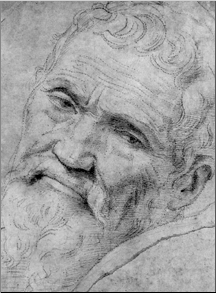An Introduction to Michelangelo’s Poetry
Although Michelangelo’s poetry is not nearly as well known to the public as his sculpture, painting and architecture, it was an important facet of his creative life and appears to have been a passionate and somewhat private secondary form of expression for the artist (he was unpublished during his lifetime, and many of the poems were gifts to friends). Michelangelo worked in the tradition of Italian lyric poetry as defined by Petrarch and Dante. Echoing Petrarch’s Laura and Dante’s Beatrice, Michelangelo often addresses a woman–who may be imagined as the poetic representation of Vittoria Colonna, with whom he had an intense friendship (now considered by scholars not to have been truly romantic).
Michelangelo wrote over three hundred poems, many of which utilized imagery or metaphors from his primary medium of marble sculpture. Fragments of verse can be found in Michelangelo’s sketchbooks, scribbled on the same pages as studies for his masterpieces, showing that these two disparate art forms were complementary or intimately related in his mind.

The poems I selected for my musical interpretation of Michelangelo’s poetry and art, Revealed in Stone (2009) for tenor and piano, center around a few of the most prevalent and intriguing themes in Michelangelo’s repertoire: time, death, and the immortalizing power of art; the artist’s concetto (conception or idea) and the perfection of its realization; the reflection of the artist’s self in his creations; the tension between hiding and revealing, which relates to the subtractive process of marble sculpture; and a yearning for spiritual release, or elevation, from the human condition.
He alludes directly to this idea with a metaphor for sculpture as the earthly confinement of an enigmatic spirit (“I came down, against my will, from a great ravine / in the high mountains to this lower place, / to be revealed within this little stone.”).